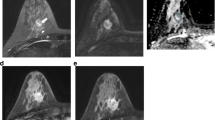Abstract
Purpose
To investigate the correlation between enhancement parameters on dynamic contrast-enhanced magnetic resonance imaging (DCE-MRI) and pathologic prognostic factors in invasive breast cancers (BCs).
Materials and methods
A total of 25 invasive BCs were included: 22 invasive ductal, 2 invasive lobular and 1 invasive mucinous. The tumor volume was segmented using a semi-automatic software (Olea Sphere). The following voxel-wise enhancement parameters were extracted: (1) time to peak enhancement; (2) signal intensity at peak (SIP); (3) peak enhancement percentage (PEP); (4) post-initial enhancement percentage (PIEP). The following pathological prognostic factors were considered for potential correlation: tumor (pT) and nodal (pN) stage, grading, perivascular/perineural invasion, estrogen/progesterone receptor status, Ki-67 proliferation, and HER2 expression. Spearman and Pearson correlation coefficients were calculated according with type of variable and data distribution.
Results
Tumor volume was 2.8 ± 2.0 cm3 (mean ± standard deviation [SD]). Mean SIP correlated with pT (ρ = 0.424, p = 0.035); mean PEP correlated with HER2 overexpression (ϕ = 0.471, p = 0.017) and pT (ρ = 0.449, p = 0.024). The percentage of voxels with fast PEP directly correlated with pT (ρ = 0.482, p = 0.015) and pN (ρ = 0.446, p = 0.026), while the percentage of voxels with slow PEP inversely correlated with pT (ρ = −0.421, p = 0.039) and pN (ρ = −0.481, p = 0.015). Segmentation time was 14.6 ± 1.3 min (mean ± SD).
Conclusion
In invasive BCs, DCE-MRI voxel-wise enhancement parameters correlated with HER2, pT, and pN.



Similar content being viewed by others
References
Siegel RL, Miller KD, Jemal A (2016) Cancer statistics. CA Cancer J Clin 66:7–30
Badve S, Dabbs DJ, Schnitt SJ et al (2011) Basal-like and triple-negative breast cancers: a critical review with an emphasis on the implications for pathologists and oncologists. Mod Pathol 24:157–167
Voduc KD, Cheang MCU, Tyldesley S, Gelmon K, Nielsen TO, Kennecke H (2010) Breast cancer subtypes and the risk of local and regional relapse. J Clin Oncol 28:1684–1691
Gasparini G (2000) Prognostic value of vascular endothelial growth factor in breast cancer. Oncologist 5:37–44
Weidner N, Folkman J, Pozza F et al (1992) Tumor angiogenesis: a new significant and independent prognostic indicator in early-stage breast carcinoma. J Natl Cancer Inst 84:1875–1887
Boné B, Szabó BK, Perbeck LG, Veress B, Aspelin P (2003) Can contrast-enhanced MR imaging predict survival in breast cancer? Acta Radiol 44:373–378
Kuhl CK (2007) The current status of breast MR imaging. Part I. Choice of technique, image interpretation, diagnostic accuracy, and transfer to clinical practice. Radiology 244:356–378
Zhang L, Tang M, Min Z, Lu J, Lei X, Zhang X (2016) Accuracy of combined dynamic contrast-enhanced magnetic resonance imaging and diffusion-weighted imaging for breast cancer detection: a meta-analysis. Acta Radiol 57:651–660
Shin HJ, Kim HH, Shin KC et al (2016) Prediction of low-risk breast cancer using perfusion parameters and apparent diffusion coefficient. Magn Reson Imaging 34:67–74
Kim JY, Kim SH, Kim YJ et al (2015) Enhancement parameters on dynamic contrast enhanced breast MRI: do they correlate with prognostic factors and subtypes of breast cancers. Magn Reson Imaging 33:72–80
Singletary SE, Allred C, Ashley P et al (2002) Revision of the American Joint Committee on cancer staging system for breast cancer. J Clin Oncol 20:3628–3636
Yi B, Kang DK, Yoon D, Jung YS, Kim KS, Yim H, Kim TH (2014) Is there any correlation between model-based perfusion parameters and model-free parameters of time-signal intensity curve on dynamic contrast enhanced MRI in breast cancer patients? Eur Radiol 24:1089–1096
Liu TJ, Sun BC, Zhao XL et al (2013) CD133 + cells with cancer stem cell characteristics associates with vasculogenic mimicry in triple-negative breast cancer. Oncogene 32:544–553
Niu G, Carter WB (2007) Human epidermal growth factor receptor 2 regulates angiopoietin-2 expression in breast cancer via AKT and mitogen-activated protein kinase pathways. Cancer Res 67:1487–1493
Schoppmann SF, Tamandl D, Roberts L et al (2009) HER2/neu expression correlates with vascular endothelial growth factor-C and lymphangiogenesis in lymph node-positive breast cancer. Ann Oncol 21:955–960
Saadatmand S, Bretveld R, Siesling S, Tilanus-Linthorst MMA (2015) Influence of tumour stage at breast cancer detection on survival in modern times: population based study in 173,797 patients. BMJ 351:h4901
Tresserra F, Rodriguez I, García-Yuste M, Grases PJ, Ara C, Fabregas R (2007) Tumor size and lymph node status in multifocal breast cancer. Breast J 13:68–71
Folkman J (1971) Tumor angiogenesis: therapeutic implications. N Engl J Med 285:1182–1186
Han C, Sun B, Wang W, Cai W, Lou D, Sun Y, Zhao X (2011) Overexpression of microtubule-associated protein-1 light chain 3 is associated with melanoma metastasis and vasculogenic mimicry. Tohoku J Exp Med 223:243–251
Boné B, Aspelin P, Bronge L, Veress B (1998) Contrast-enhanced MR imaging as a prognostic indicator of breast cancer. Acta Radiol 39:279–284
Sardanelli F, Esseridou A, Del Sole A, Sconfienza LM (2012) Response to treatment: the role of imaging. In: Aglietta M, Regge D (eds) Imaging tumor response to treatment. Springer, Milano, pp 15–37
Koo HR, Cho N, Song IC et al (2012) Correlation of perfusion parameters on dynamic contrast-enhanced MRI with prognostic factors and subtypes of breast cancers. J Magn Reson Imaging 36:145–151
Hood L, Friend HS (2011) Predictive, personalized, preventive, participatory (P4) cancer medicine. Nat Rev Clin Oncol 8:184–187
Author information
Authors and Affiliations
Corresponding author
Ethics declarations
Conflict of interest
Daniela Casolino is product manager for Olea Sphere software at MTS s.r.l. Other authors declare that they have no conflict of interest.
Ethical standards
The work has been approved by the Local Ethical Committee, protocol code OLEA_01 on June 2, 2016. For this type of study formal consent is not required.
Rights and permissions
About this article
Cite this article
Trimboli, R.M., Codari, M., Khouri Chalouhi, K. et al. Correlation between voxel-wise enhancement parameters on DCE-MRI and pathological prognostic factors in invasive breast cancers. Radiol med 123, 91–97 (2018). https://doi.org/10.1007/s11547-017-0809-8
Received:
Accepted:
Published:
Issue Date:
DOI: https://doi.org/10.1007/s11547-017-0809-8




